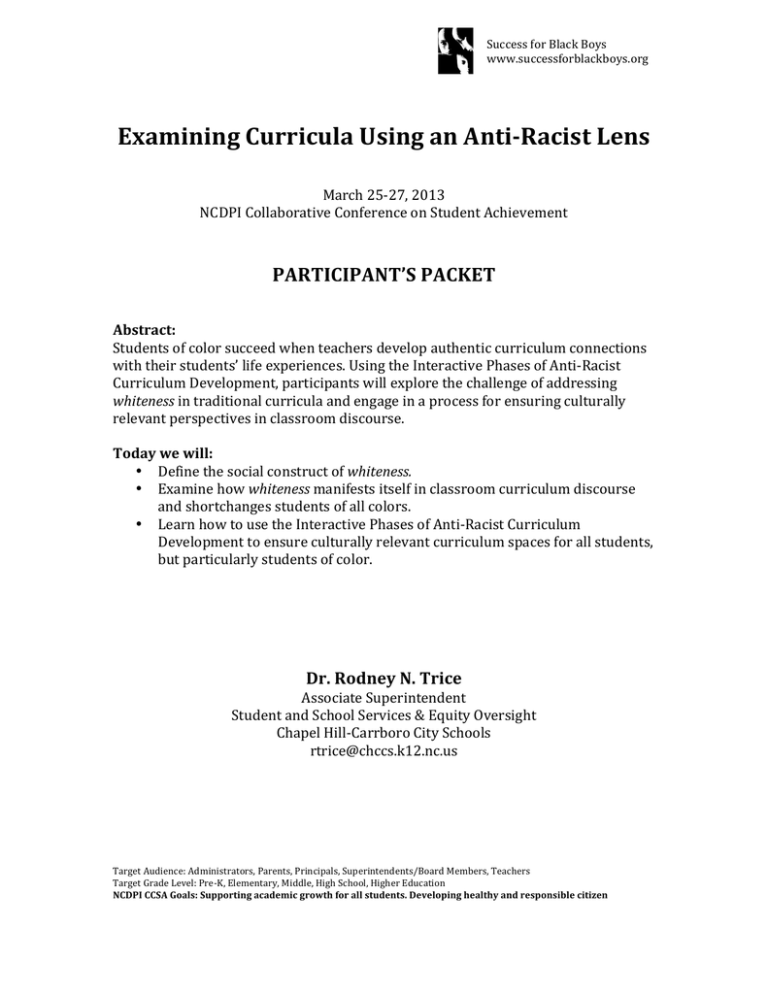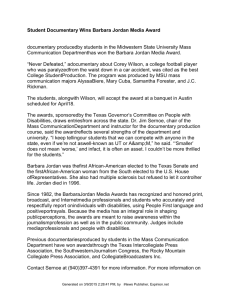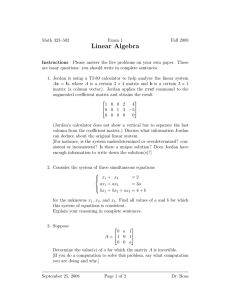Document 10823287
advertisement

Success for Black Boys www.successforblackboys.org Examining Curricula Using an Anti-­Racist Lens March 25-­‐27, 2013 NCDPI Collaborative Conference on Student Achievement PARTICIPANT’S PACKET Abstract: Students of color succeed when teachers develop authentic curriculum connections with their students’ life experiences. Using the Interactive Phases of Anti-­‐Racist Curriculum Development, participants will explore the challenge of addressing whiteness in traditional curricula and engage in a process for ensuring culturally relevant perspectives in classroom discourse. Today we will: • Define the social construct of whiteness. • Examine how whiteness manifests itself in classroom curriculum discourse and shortchanges students of all colors. • Learn how to use the Interactive Phases of Anti-­‐Racist Curriculum Development to ensure culturally relevant curriculum spaces for all students, but particularly students of color. Dr. Rodney N. Trice Associate Superintendent Student and School Services & Equity Oversight Chapel Hill-­‐Carrboro City Schools rtrice@chccs.k12.nc.us Target Audience: Administrators, Parents, Principals, Superintendents/Board Members, Teachers Target Grade Level: Pre-­‐K, Elementary, Middle, High School, Higher Education NCDPI CCSA Goals: Supporting academic growth for all students. Developing healthy and responsible citizen Success for Black Boys www.successforblackboys.org Task Sheet 1: Unpacking “Oblivion” 1. Workshop participants must organize themselves based on the people listed on each white card. 2. QUICK WRITE: What feelings/emotions did this exercise bring up for you? (Share your quick write with your table partners. Be prepared to discuss as a whole group) 2 Success for Black Boys www.successforblackboys.org Task Sheet 2: The Exceptional Other (Rosa Parks) Take 3 minutes and write down everything you know about Rosa Parks in this column. (Share with your table partners) 3 Success for Black Boys www.successforblackboys.org Task Sheet 3: Phase III -­‐ Problems & -­‐ism(s) 1. Review the characteristics of Phase III: Problems & -­‐ism(s). 2. Watch Chimamanda Adichie’s The danger of a single story. Reflect on how her story is grounded in phase III. 3. Be prepared to discuss your thoughts as a whole group after the video. Characteristics of Phase III: Problems & -­ism(s) • • • • • • Requires more anger and critique than phases I and II Study of racism (overt violence, persecution and protest) History of the losers (can become arrested in victim study) Critiques issues of racial oppression all over the world Ascribes race only to people of color A Weakness of Phase III is that it never asks ordinary people about their lives; never sees children, women and servants as authorities of knowledge. • • • • This phase can reinforce -­‐ism(s) and deficit identify if only ascribed to people of color. This phase never does a full analysis of the oppressor’s psyche or pathology. Phase III says to students of color, you are a fighter not a contributor to culture making; and to white students, your culture is superior to other cultures. A sign of growth when teachers begin practice in phase III and pass on the important skills to critique social inequalities and power structures PARTICIPANT OBSERVATION NOTES: 4 Success for Black Boys www.successforblackboys.org Task Sheet 4: Using the Phases of Anti-­‐Racist Curriculum Development 1. As a table group, review one of the following three curriculum tasks. (Be prepared to discuss as a whole group) Curriculum Task Directions Curriculum Task 4.1 (Page 6) All Together Now by Barbara Jordan Using the Interactive Phases of Anti-­‐Racist Curriculum Development worksheet, identify the phase to which task 4.1 most aligns. Curriculum Task 4.2 (Page 8) 2013-­‐2014 New Course Proposals Using the Interactive Phases of Anti-­‐Racist Curriculum Development worksheet, identify the phase to which each course proposal most aligns. Curriculum Task 4.3 (Page 9) Civil War Lesson Plan Using the Interactive Phases of Anti-­‐Racist Curriculum Development worksheet, identify the phase to which task 4.3 most aligns. 5 Success for Black Boys www.successforblackboys.org Curriculum Task 4.1 All Together Now by Barbara Jordan Directions: Read Barbara Jordan's speech, "All Together Now." As you read, pay attention to Jordan's comments about prejudice, tolerance, and equality. Think about what you learn about Ms. Jordan—what type of person she is—based on what she says is important to her in the speech. All Together Now by Barbara Jordan (Speech delivered at the Democratic National Convention in 1992) When I look at race relations today I can see that some positive changes have come about. But much remains to be done, and the answer does not lie in more legislation. We have the legislation we need; we have the laws. Frankly, I don't believe that the task of bringing us all together can be accomplished by government. What we need now is soul force-­‐-­‐the efforts of people working on a small scale to build a truly tolerant, harmonious society. And parents can do a great deal to create that tolerant1 society. We all know that race relations in America have had a very rocky history. Think about the 1960's when Dr. Martin Luther King, Jr., was in his heyday and there were marches and protests against segregation2 and discrimination. The movement culminated in 1963 with the March on Washington. Following that event, race relations reached an all-­‐time peak. President Lyndon B. Johnson pushed through the Civil Rights Act of 1964, which remains the fundamental piece of civil rights legislation in this century. The Voting Rights Act of 1965 ensured that everyone in our country could vote. At last, black people and white people seemed ready to live together in peace. But that is not what happened. By the 1990's the good feelings had diminished. Today the nation seems to be suffering from compassion fatigue, and issues such as race relations and civil rights have never regained momentum. Those issues, however, remain crucial. As our society becomes more diverse, people of all races and backgrounds will have to learn to live together. If we don’t think this is important, all we have to do is look at the situation in Bosnia today. How do we create a harmonious society out of so many kinds of people? The key is tolerance—the one value that is indispensable in creating community. If we are concerned about community, if it is important to us that people not feel excluded, then we have to do something. Each of us can decide to have one friend of a different Adapted from Language Arts with Miss Soriano missnsoriano.weebly.com Retrieved February 1, 2013 6 Success for Black Boys www.successforblackboys.org race or background in our mix of friends. If we do this, we’ll be working together to push things forward. One thing is clear to me: We, as human beings, must be willing to accept people who are different from ourselves. I must be willing to accept people who don’t look as I do and don’t talk as I do. It is crucial that I am open to their feelings, their inner reality. What can parents do? We can put our faith in young people as a positive force. I have yet to find a racist baby. Babies come into the world as blank as slates and, with their beautiful innocence, see others not as different but as enjoyable companions. Children learn ideas and attitudes from the adults who nurture them. I absolutely believe that children do not adopt prejudices unless they absorb them from their parents or teachers. The best way to get this country faithful to the American dream of tolerance and equality is to start small. Parents can actively encourage their children to be in the company of people who are of other racial and ethnic backgrounds. If a child thinks, “Well, that person’s color is not the same as mine, but she must be okay because she likes to play with the same things I like to play with,” that child will grow up with a broader view of humanity. I’m an incurable optimist. For the rest of the time that I have left on this planet I want to bring people together. You might think of this as a labor of love. Now, I know that love means different things to different people. But what I mean is this: I care about you because you are a fellow human being and I find it okay in my mind, in my heart, to simply say to you, I love you. And maybe that would encourage you to love me in return. It is possible for all of us to work on this—at home, in our schools, at our jobs. It is possible to work on human relationships in every area of our lives. Writing Task In her speech, Barbara Jordan discusses the issues of prejudice, tolerance, and equality in the United States. She makes it very clear what her beliefs and feelings are on these topics. From her comments, we can understand the type of person Barbara Jordan is and what is important to her. Discuss Barbara Jordan's characteristics with your table group. Next, write a brief essay that includes specific information about what you can infer about her traits-­‐-­‐ what type of person she is, what she cares about, and/or what is important to her. Use specific passages from the text to explain your thesis. Adapted from Language Arts with Miss Soriano missnsoriano.weebly.com Retrieved February 1, 2013 7 Success for Black Boys www.successforblackboys.org Curriculum Task 4.2 2013-­‐2014 New Course Proposals Music Theory and Appreciation Music Appreciation and Music Theory is open to all students and provides a non-­‐ performance musical offering. Students hone their listening skills through exploration of the six elements of music: melody, rhythm, harmony, form, timbre and expressive elements. The course takes a sociological, humanities-­‐based approach more than a technical approach, including such units of study as “Music in Other Cultures,” “Controversy in Music,” “Jazz,” and many more. It also provides a solid foundation prerequisite course to the AP Music Theory offering. It provides an introduction to theoretical practices of the Western World beginning with the fundamentals of reading music notation and extending into harmonic practices. Students also receive some basic instruction in sight-­‐singing, aural dictation and ear training. Common Core English 9 Social Justice Perspective Common Core English 9 Social Justice Perspective provides a foundational study of literary genres (novels, short stories, poetry, drama, literary nonfiction). It includes influential US documents and one Shakespearean play. Through disciplined reading of complex literary fiction and literary non-­‐fiction, students develop critical thinking skills, value evidence and build academic language to engage in lively discussions with their peers about issues of justice and equality emphasized in the course readings. Issues of power and authority are also examined in various texts. All writing is integrated with grammar and technique of style. Students develop their writing skills through authentic writing assignments, projects, research and literary analysis. Students work collaboratively with their peers to accomplish learning goals. Core Works may include John Steinbeck’s Of Mice and Men, William Golding’s Lord of the Flies, and George Orwell’s Animal Farm. Mathematics for World Justice This course uses mathematics to discuss social and economic issues as well as ethnomathematics. Ethnomathematics is the study of mathematical practices from various cultures from both historical and contemporary perspectives, including: symbolic systems; spatial designs; calculation methods; measurement in time and space; and architecture and design. Students develop their mathematical literacy to recognize the power of mathematics as an essential analytical tool to understand the world. Examples of topics include voting rights and practices; statistical misconceptions and their consequences; and injustices such as financial exploitation of the quantitatively illiterate. Chapel Hill-­Carrboro City Schools High School Course Book Retrieved February 1, 2013 8 Success for Black Boys www.successforblackboys.org Curriculum Task 4.3 Civil War Lesson Plan How Population and Supplies Affected the Outcome of the Civil War At the beginning of the Civil War unit, separate the class into two equal teams called "North" and "South." The teacher can provide each player with the appropriate number of markers (poker chips, toothpicks, tickets or bright scraps of paper all work fine for this purpose). At some point during the unit, when the teacher decides it to be an appropriate time, the North team will compete against the South to play “WAR!” Choose the game that best suits your educational purposes. Game A is probably more appropriate for younger students, but both work well with older classes. Game A: The Population Game One student from the “South” represents one soldier. However, because of the population differences between the two regions (22 million in the North, 9 million in the South), one student from the “North” equals three soldiers. One student from each team comes up to the teacher’s desk or neutral table and draws the top card from the deck. Whoever draws the higher card stays in; the other soldier is defeated and must turn in a marker. When the student has no more markers, he/she must sit down and remain silent. If a student loses but still has markers, he/she goes to the end of the line and waits for another turn. The game can also be set up as a quiz, with the student turning in a chip each time he or she gives an incorrect answer. You’ll need LOTS of questions! Game B: The Supply Game This game is played by the same rules as the Population Game, but in this case the markers represent supplies (food, horses, wagons, tents, blankets, medical supplies, uniforms, boots, rifles, cannons, ammunition, etc.). If you want to make the game more interesting, you can designate different colors to represent different types of supplies, or even use pictures of the items, so that the teams are forced to make choices about what supplies to surrender, and the “South” can watch their “losses” developing in a more dramatic fashion. Going through either game, students should realize that, barring some improbable luck, the South has virtually no way of winning the game. In this way, students can conceptualize how the much larger wealth and population of the North could be a tremendous advantage during the Civil War. The ensuing discussion about the game will lead very naturally into further conversation about the advantages/disadvantages of the North/South. Adapted from Middle Tennessee State University http://cem.mtsu.edu/sites/default/files/k_12/video_handouts/Civil%20War%20Lesson%20Plans.pdf Retrieved February 1, 2013 9 Success for Black Boys www.successforblackboys.org Task Sheet 5: Reflection…I used to think and now I think 1. Individually, take 5 minutes to complete the reflection task below. Jot down how what we’ve been discussing today may influence you to rethink unit, lesson and/or curriculum planning. (Be prepared to discuss as a whole group) I Used to Think Now I Think 10




